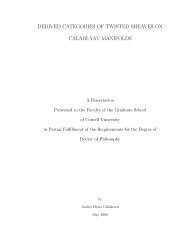Modifications of the Harmonic Series - Department of Mathematics
Modifications of the Harmonic Series - Department of Mathematics
Modifications of the Harmonic Series - Department of Mathematics
Create successful ePaper yourself
Turn your PDF publications into a flip-book with our unique Google optimized e-Paper software.
series will be partitioned in <strong>the</strong> same manner as in Section 2.1 – <strong>the</strong> i th group will be<br />
<strong>the</strong> terms that have exactly i digits in <strong>the</strong> denominator. Then we can calculate<br />
Ni<br />
910 i<br />
= ⋅<br />
−1<br />
, and choose<br />
M i<br />
1<br />
10 i−<br />
= . It is easy to see that M i+ 1Ni+ 1 MiNi −<br />
converges, and { MiN i}<br />
is monotonically decreasing. So any modification that uses<br />
this partitioning will automatically have <strong>the</strong> second conditions <strong>of</strong> both Theorem 1 and<br />
Theorem 2 satisfied.<br />
If we modify <strong>the</strong> series by removing <strong>the</strong> terms that contain <strong>the</strong> digit nine, <strong>the</strong>n,<br />
using <strong>the</strong> above partitioning,<br />
ri<br />
∑<br />
1<br />
89 i−<br />
= ⋅ and <strong>the</strong>refore ( ) 1<br />
8 9<br />
i−<br />
pi<br />
9 10<br />
= ⋅ . So, using ei<strong>the</strong>r<br />
Theorem 1 or Theorem 2, we see that this modification converges – as we have<br />
already shown.<br />
Ano<strong>the</strong>r modification is to remove all <strong>of</strong> <strong>the</strong> terms that have two consecutive<br />
digits alike [7]. For example, <strong>the</strong> terms 1 22and 1 75548 would be removed, but <strong>the</strong><br />
term 1 8384 would remain. To check for convergence we use <strong>the</strong> same partitioning<br />
and calculate 9 and<br />
i<br />
also converges.<br />
r = ( ) 1<br />
9<br />
i<br />
i<br />
p<br />
i<br />
−<br />
= . Since 10<br />
i p ∑ converges, this modified series<br />
We can apply <strong>the</strong>se <strong>the</strong>orems to many o<strong>the</strong>r modifications <strong>of</strong> <strong>the</strong> harmonic<br />
r i<br />
series. Several modifications are listed in Table 3, along with <strong>the</strong>ir and<br />
i<br />
p values<br />
and <strong>the</strong> result <strong>of</strong> using Theorem 1 and Theorem 2 as a convergence test. The two<br />
modifications discussed above are also included for completion. Note that all <strong>the</strong><br />
convergence tests for <strong>the</strong> modifications below use <strong>the</strong> same partitioning as above and<br />
<strong>the</strong>refore have M i+ 1Ni+ 1 MiNi − ∑ converging, and { MiN i}<br />
monotonically<br />
decreasing.<br />
17
















